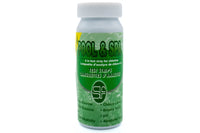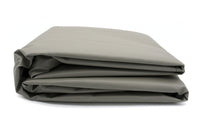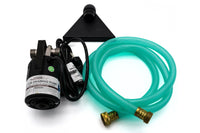As we’ve covered on this blog, hot tub maintenance isn’t rocket science. It’s more like an introductory course on chemistry. Armed with a few select bottles, a little know-how, and a simple maintenance schedule, you should be able to get into an “auto-pilot” routine.
One of the most fundamental components of hot tub chemistry will be balancing pH. When your hot tub sees more use, you might notice the pH levels nose-diving, which can impact the overall comfort of your soak and the longevity of your investment.
Whether you’re a novice hot tub owner or seasoned soaker, this article answers all your burning questions. What is pH? Why does it matter? Why does the pH drop? How do I test it? How do I prevent fluctuations in the future? And—most importantly—what steps can I take to raise my hot tub’s pH levels? These questions are anything but basic.
Flip on the jets, get comfortable, and let’s sink in.
What Is pH and Why Does It Matter?
Short for “potential of hydrogen,” pH refers to a scientific scale that measures the acidity or basicity (basicness) of water-based solutions. Acidic things like lemon juice and vinegar are low-pH; basic stuff like baking soda and body wash are high-pH.
We come into contact with the scale all the time without even realizing it. Soda manufacturers test the pH of their drinks to maintain enough acidity to cut through the sweetness. Cleaning brands rigorously test the pH of their bleach, borax and ammonia products for basicness to ensure they’re effective against bacteria. Even coffee chains break out the pH strips to make sure your morning joe sits at a comfortable, tart “5” on the pH scale.
For hot tubs, managing pH means managing comfort and longevity. Low-pH hot tub water (read: slightly acidic) can cause itchy or dry skin, as well as creating a favorable environment for harmful pathogen growth by decreasing the effectiveness of sanitizers. Moreover, low-pH water places strain on your investment, potentially corroding the metal parts like pumps, heaters, and jets; it can also etch and stain the acrylic or fiberglass surfaces of the tub. This is why experts consider pH balancing an essential facet of proper hot tub maintenance.
What’s Considered an Ideal pH for Hot Tubs?
The pH scale runs from 0 to 14. The ideal level for a hot tub should be more or less in the neutral middle: within the 7.2 to 7.8 range.
Certain caveats and tweaks exist. If you’re using well water or hard water, you want to test diligently to ensure that your pH is between 7.0 and 7.4, with 7.4 being the absolute maximum allowable pH. If you’re using chlorine-based sanitizers, 7.8 needs to be your ceiling, as chlorine loses its effectiveness around 7.8 and becomes an oxidizing agent if the pH spikes any higher. A good option for those who don’t want to obsessively break out the pH strips is to use bromine-based tablets like the ones from Spa Boss, which work with a wider range of pHs.
How to Test Your Tub’s pH Levels
Before you go shaking a box of baking powder into the tub, you need to test the waters—literally. Understanding the current pH in your hot tub will guide how much increaser you use.
Thankfully, this is a simple and inexpensive process:
- Grab yourself a bottle of 4-way test strips for hot tub water (which also measure the alkalinity, chlorine and bromine levels in the tub, as a bonus!).
- Scoop a water sample into a clean cup, or stick the test strip right into the water; either way, you want to submerge the strip for a few seconds.
- Next, pull the test strip out and hold it horizontally. In a matter of seconds, it will change colors.
- Compare the strip’s color next to the reference colors on the bottle to determine the pH of your water.
- You will also want to pay attention to the total alkalinity reading (for reasons we explore below).
All told, the test takes maybe 30 seconds to complete. Not like the science tests you remember from your school days! This fastness is a blessing on winter days when you’re fighting against the cold to get your tub up-and-running.

Back to Basic: How to Raise the pH in Your Hot Tub
Let’s say you have a test result and—lo and behold—it’s too low. It’s a common occurrence. When people use the hot tub, they leave behind all sorts of contaminants that can lower the tub’s pH (more on the causes of low pH below). Your job is get back to basic.
But first, it’s essential to balance the alkalinity in the tub. Alkalinity is basically a pH buffer: It helps stabilize the pH and prevent it from vacillating too rapidly. That same 4-way test strip will gauge your alkalinity, which should be between 80 and 120 PPM. If it’s under that range, add spa alkalinity booster; follow the recommended amount and directions on the product package, waiting a little while for the booster to take effect.
This might solve your pH issue by itself. Take another strip and test pH levels again to determine where things are at. If the alkaline levels are right, but the pH is still low, you can move onto the next parts of the process:
- Choose the right pH increaser: Our selection of pH balancers are highly effective, designed specifically for hot tubs.
- Safely add the chemicals: Follow the directions on the package and use gloves for good measure.
- Test again: Remember, you’re aiming for a pH of between 7.2 and 7.8 (unless your tub falls under one of the exceptions detailed above).
- Wait a while before jumping in: Let the product work its magic and circulate around the tub. We know it’s tempting to jump right in, but it’s better to wait a couple of hours before a soak.
- Build this process in a regular maintenance regimen: If you came to this article looking for a one-time quick-fix, we apologize. Now is the best time to build pH management into a regular routine. Keep a chart near the hot tub, if need be, or simply set reminders on your calendar to test and manage the pH and alkalinity.
While you’re at it, you might as well incorporate a few other tests and tweaks that help your hot tub perform at peak functionality:
- Testing and adjusting for calcium hardness: You can use calcium chloride tabs for this.
- Regularly sanitizing the tub water: Bromine and chlorine are popular choices for sanitization.
- Shocking your tub to remove organic matter: We like the Spa Boss “Spa-Shock” for this weekly job.
You can find all of the tests, balancers and hot tub chemicals you need for the job on The Cover Guy website.
Understanding and Troubleshooting pH Fluctuations
Down at the bottom of the article here, let’s discuss why the pH in hot tubs drops, and brainstorm ways to troubleshoot persistent issues.
Hot tub pH can drop for various reasons, but the most common culprits are contaminants. Contaminants can hitch a ride via the hot tub users in the form of sunscreen, hair/body products, skin cells, saliva, etc. However, contaminants can also be natural, like rainwater, fallen leaves and other backyard detritus. (As a side note, this is another reason why it’s essential to have a great-quality hot tub cover!) These contaminants strain the sanitizer in your tub, making the water more acidic.
If you’re noticing persistent, wild fluctuations in pH, you can investigate further. Occasionally, you might have so many contaminants in the water that balancing the pH level becomes tricky. In these cases, it’s a good idea to clean your hot tub, including filters and jets.
Sometimes, persistent pH problems come as a result of faulty or malfunctioning equipment, like the pump, filters or heaters, which can cause poor circulation and uneven chemical distribution. If you suspect there’s something wrong with your equipment, call in an expert hot tub maintenance company to take a peek.
Lastly, persistently big swings in pH might boil to human error. In an effort to quickly solve the problem, you might reasonably decide to add lots of increaser. Remember, less is more. Always follow the directions on the product package for best results.
That’s about all you need to know. To summarize, get yourself some inexpensive test strips, alkalinity booster, and pH increaser. Test the waters, adjust accordingly, and build this process into your regular hot tub maintenance routine. As a reward, you’ll enjoy better soaks in the tub, and a longer functional life for your investment.
For all your pH balancing needs, as well as several other hot tub-related essentials, you can easily buy hot tub accessories through The Cover Guy website. Peruse the drop-down menus on the top bar (right up there) to get started.












